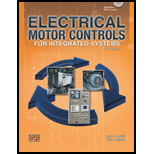
Electrical Motor Controls for Integrated Systems
5th Edition
ISBN: 9780826912268
Author: Gary Rockis;Glen A. Mazur
Publisher: American Technical Publishers
expand_more
expand_more
format_list_bulleted
Question
Chapter 6.3, Problem 1CP
To determine
To explain: The main advantage of using a joystick in an application such as moving the passenger loading ramp to and from an airplane door.
Expert Solution & Answer
Want to see the full answer?
Check out a sample textbook solution
Students have asked these similar questions
Don't use ai to answer I will report you answer
NO AI PLEASE WILL REJECT
NO AI PLEASE WILL REJECT
Chapter 6 Solutions
Electrical Motor Controls for Integrated Systems
Ch. 6.1 - Prob. 1CPCh. 6.1 - Prob. 2CPCh. 6.1 - Prob. 3CPCh. 6.1 - Prob. 4CPCh. 6.2 - Prob. 1CPCh. 6.2 - Prob. 2CPCh. 6.2 - Prob. 3CPCh. 6.2 - Prob. 4CPCh. 6.3 - Prob. 1CPCh. 6.3 - Prob. 2CP
Ch. 6.4 - Prob. 1CPCh. 6.4 - Prob. 2CPCh. 6.4 - Prob. 3CPCh. 6.4 - Prob. 4CPCh. 6.5 - Prob. 1CPCh. 6.5 - Prob. 2CPCh. 6.6 - Prob. 1CPCh. 6.6 - Prob. 2CPCh. 6.7 - Prob. 1CPCh. 6.7 - Prob. 2CPCh. 6.8 - Prob. 1CPCh. 6.8 - Prob. 2CPCh. 6.9 - Prob. 1CPCh. 6.9 - Prob. 2CPCh. 6.10 - Prob. 1CPCh. 6.10 - Prob. 2CPCh. 6.10 - Prob. 3CPCh. 6.10 - Prob. 4CP
Knowledge Booster
Similar questions
- Don't use ai to answer I will report you answer. Please give explanation for both correct options and incorrectarrow_forward14:00 APP Voi) 5G 鼷浴醵郯興47% atheva.cc/index/index/index.html The Most Trusted, Secure, Fast, Reliable Cryptocurrency Exchange Get started with the easiest and most secure platform to buy, sell, trade, and earn Cryptocurrency Balance:1000.00 Recharge Withdraw Message About us BTC/USDT ETH/USDT EOS/USDT 83259.00 1841.46 83259.00 +1.02% +0.08% +1.02% Operating norms Symbol B BTC/USDT Latest price 24hFluctuation 83259.00 +1.02% ETH/USDT 1841.46 +0.08% B BTC/USD illı 83259.00 +1.02% Home Markets Trade Record Mine О <arrow_forwardPastner Brands is a calendar-year firm with operations in several countries. As part of its executive compensation plan, at January 1, 2024, the company issued 480,000 executive stock options permitting executives to buy 480,000 shares of Pastner stock for $38 per share. One-fourth of the options vest in each of the next four years beginning at December 31, 2024 (graded vesting). Pastner elects to separate the total award into four groups (or tranches) according to the year in which they vest and measures the compensation cost for each vesting date as a separate award. The fair value of each tranche is estimated at January 1, 2024, as follows: Vesting Date Amount Fair Value Vesting per Option: December 31, 2024 25% $ 3.90 December 31, 2025 25% $ 4.40 25% $ 4.90 25% $ 5.40 December 31, 2026 December 31, 2027 Required: 1. Determine the compensation expense related to the options to be recorded each year 2024-2027, assuming Pastner allocates the compensation cost for each of the four…arrow_forward
- JOB UPDATE Apply on- Jobswood.com OR Search "Jobswood.com" on Google COMPANY JOB PROFILE JOB LOCATION WEB ENGINEER GOOGLE MULTIPLE CITIES (FRESHERS) AMAZON SOFTWARE DEV ENGG MULTIPLE CITIES COGNIZANT SYSTEMS ENGINEER CHENNAI ZENSAR FRONTEND DEVELOPER BENGALURU ORACLE AUTOMATION ENGINEER BENGALURU DIGITAL OCEAN SUPPORT ENGINEER HYDERABAD IBM APPLICATION DEVELOPER HYDERABAD INDIAMART WORK FROM HOME MULTIPLE CITIES AMAZON RECRUITER HYDERABAD GE HEALTHCARE TRAINEE ENGINEER BENGALURUarrow_forwardJOB UPDATE Apply on Vinkjobs.com OR Search "VinkJobs.com" on Google Company Name Job Profile Job Location CISCO Software Engineer Bengaluru Accenture Associate (Freshers) Chennai Trellix Developer Bengaluru Verizon SDET Bengaluru Allerin Test Engineer Mumbai Sutherland SQL/.Net Developer Chennai Bottomline DevOps Engineer Multiple Cities IQVIA HRIS Specialist Bengaluru BYJU's Associate Multiple Cities Spring Works Executive WFH (Remote)arrow_forwardDon't use ai to answer I will report you answerarrow_forward
arrow_back_ios
SEE MORE QUESTIONS
arrow_forward_ios
Recommended textbooks for you
 Introductory Circuit Analysis (13th Edition)Electrical EngineeringISBN:9780133923605Author:Robert L. BoylestadPublisher:PEARSON
Introductory Circuit Analysis (13th Edition)Electrical EngineeringISBN:9780133923605Author:Robert L. BoylestadPublisher:PEARSON Delmar's Standard Textbook Of ElectricityElectrical EngineeringISBN:9781337900348Author:Stephen L. HermanPublisher:Cengage Learning
Delmar's Standard Textbook Of ElectricityElectrical EngineeringISBN:9781337900348Author:Stephen L. HermanPublisher:Cengage Learning Programmable Logic ControllersElectrical EngineeringISBN:9780073373843Author:Frank D. PetruzellaPublisher:McGraw-Hill Education
Programmable Logic ControllersElectrical EngineeringISBN:9780073373843Author:Frank D. PetruzellaPublisher:McGraw-Hill Education Fundamentals of Electric CircuitsElectrical EngineeringISBN:9780078028229Author:Charles K Alexander, Matthew SadikuPublisher:McGraw-Hill Education
Fundamentals of Electric CircuitsElectrical EngineeringISBN:9780078028229Author:Charles K Alexander, Matthew SadikuPublisher:McGraw-Hill Education Electric Circuits. (11th Edition)Electrical EngineeringISBN:9780134746968Author:James W. Nilsson, Susan RiedelPublisher:PEARSON
Electric Circuits. (11th Edition)Electrical EngineeringISBN:9780134746968Author:James W. Nilsson, Susan RiedelPublisher:PEARSON Engineering ElectromagneticsElectrical EngineeringISBN:9780078028151Author:Hayt, William H. (william Hart), Jr, BUCK, John A.Publisher:Mcgraw-hill Education,
Engineering ElectromagneticsElectrical EngineeringISBN:9780078028151Author:Hayt, William H. (william Hart), Jr, BUCK, John A.Publisher:Mcgraw-hill Education,

Introductory Circuit Analysis (13th Edition)
Electrical Engineering
ISBN:9780133923605
Author:Robert L. Boylestad
Publisher:PEARSON

Delmar's Standard Textbook Of Electricity
Electrical Engineering
ISBN:9781337900348
Author:Stephen L. Herman
Publisher:Cengage Learning

Programmable Logic Controllers
Electrical Engineering
ISBN:9780073373843
Author:Frank D. Petruzella
Publisher:McGraw-Hill Education

Fundamentals of Electric Circuits
Electrical Engineering
ISBN:9780078028229
Author:Charles K Alexander, Matthew Sadiku
Publisher:McGraw-Hill Education

Electric Circuits. (11th Edition)
Electrical Engineering
ISBN:9780134746968
Author:James W. Nilsson, Susan Riedel
Publisher:PEARSON

Engineering Electromagnetics
Electrical Engineering
ISBN:9780078028151
Author:Hayt, William H. (william Hart), Jr, BUCK, John A.
Publisher:Mcgraw-hill Education,